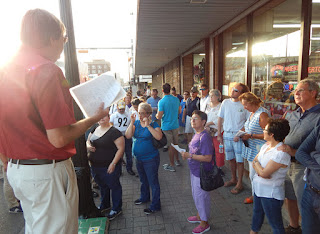Executive Director for BHA Tara Putegnat introduced Jim Mills who served as moderator for the panel speakers.
Dr. Antonio Zavaleta, James Lieker and Joseph Chance exchanged views and theories surrounding the shooting which was blamed on Fort Brown soldiers of the 25th Infantry.
Harry Lembeck, who sat with his wife Emily, joined the discussion when called upon add his 2¢
The Historic Alonso Building was the perfect setting for this fascinating discussion.
We enjoyed a dish of what someone named as a chicken "Tamalateca" served with rice and beans followed by a sweet dessert before Mr. Lembeck began his presentation.Mr. Lembeck used this map included in his book to illustrate the route taken by raiders the night of August 13th, 1906. The maps arrows indicate that shots were fired from area where town and fort met and alleys and streets raiders traversed on before splitting into two groups.
Harry's book focuses on the Brownsville incident and aftermath in which Senator Joseph Foraker challenges the authority of Roosevelt to discharge without honor 167 soldiers without a hearing. His book does not aim to uncover the truth of what happned but rather how the incident changed politics and direction African-American minority civil rights advocates would take.
A small display at the Historic Alonso Building gave a good account of the excitement created by the incident after the shooting in 1906.
This was the kind of testimony which was rejected when investigators asked questions to townspeople after the raid. With several investigations private and secret and lengthy Senate reviews into the matter to discover who the guilty persons were, no hard evidence or incriminating statements could ever be secured. According to Lembeck, Roosevelt acted in haste out of frustration with the townspeople and government people assigned to get to the bottom of the matter when he made the decision to punish the soldiers for their alleged "conspiracy of silence."
Folks who purchased a book stayed to have it signed after the presentation.
Leanne Barreda and her husband Mark getting their autographed copy of the book.
Harry Lembeck with BHA Education and Program Director Craig Stone with poster and listing of sponsors who made the two-day event possible.
The three panelists did an excellent job of presenting their "points" on the matter and it would be great to see Dr. Tony Zavaleta, Dr. Joe Chance and Dr. James Lieker come together for an extended amount of time to hear all they could have on the matter had there been more time. Thanks to all these gentlemen for agreeing to participate. We missed seeing long-time Brownsville historian Dr. Tony Knopp who would have also been on the panel but is he is on vacation with his wife Alma. Next time Dr. Knopp!
Thanks to all who attended either event and showed their support for the work our local historical association does for our benefit. We may never know who shot up the town but talking about it brings up more interesting questions about the case which make this one of Brownsville's most controversial and until recently, least talked about subjects. At the end of the discussion there was talk about taking steps to place a marker in the former Fort Brown property (perhaps near or on Jacob Brown Memorial Center lawn facing International Blvd where army barracks once stood) to acknowledge the incident happened. I hope to report on that in the near future.
TAKING ON THEODORE ROOSEVELT Webpage here!























































